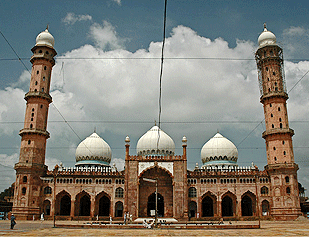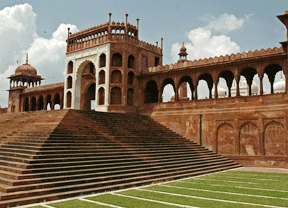|
|
|
Information about
Mandu
|
|
Mandu is situated about 90 kms. from Indore. Mandu, also known as Shadibad, which means the city of joy. Mandu was fortified as early as the 6th century, but gained prominence in the 10th century as the fort capital of the Parmar rulers of Malwa. Mandu is perched along the Vindhyan ranges at 592 m. Later, towards the end of the 13th century it came under the sway of the Sultans of Malwa, under whom it was named Shadiabad. It is now a romantic ghost city remarkably intact over an area of 12 square km. Mandu is situated on an isolated hill top which is separated from the tableland to the north by a deep and wide valley over which a natural causeway runs to the main city gate. Mandu is the largest standing fortified town in the world. The walls of Mandu have a circumference of 75 km. The walls look the same as they did some 300 years ago. There is an abundance of mango, tamarind and banyan trees. The city is particularly beautiful immediately after the monsoons, a emerald green landcape full of waterfalls. There are lakes, groves, gardens and palaces. The best season to visit Mandu is from June to September, when the tanks are full and the rain turns the entire countryside into a verdant green. |
|
|
|
|
History of Mandu
|
|
Mandu was founded by Raja Bhoj in the 10th century as a fortress and retreat. It was taken over by Afghan rulers in the 14th century. The hilltop fort of Mandu was founded in the 10th century, but it was only in the 15th century, under the rule of the Afghan governor of Malwa, that it flourished. Most of its buildings like Jahaz Mahal, Hindola Mahal, Rupamati’s Pavilion and the Jama Masjid were erected between 1401 and 1529. Its construction activity was at its peak under its two rulers Mohamud Shah and Ghiasuddin. In 1469, the sensualist Ghiyas-ud-din inherited the throne from his father Mohammed Shah. The character of his reign is typified by the Jahaz Mahal, which, with its vast rooms, pools and decorative arches, was said to house Ghiyas-ud-din 15,000 womens. Mandu saw its greatest spectacle on March 13,1617 when it heralded the entry of Jahangir with a procession of 500 elephants. The Mughals later took this fort from the Afghans. Under Mughal rule, Humayun captured Mandu in a brilliant campaign in Malwa in 1534, and it became a pleasure resort. However, by the end of the Mughal period it had effectively been abandoned and in 1732, it passed into Maratha hands. The Marathas moved their capital to neighbouring Dhar, leaving Mandu deserted as it is today.
Mandu is also known for a very romantic love story between its last King Baz Bahadur and his love Rani Rupmati – a lovely Rajput peasant girl. He fell in love with Rupmati as he heard her singing in a forest and brought her to his palace. He was so involved with her that he built several buildings for his queen but had to flee in the face of Akbar’s army. Rupmati was captured for the pleasure of the Mughal General. But, before he could touch her, she committed suicide by swallowing ground diamonds. |
|
|
|
|
Tourist Attractions in Mandu |
|
The tourist attractions in Mandu are the Jama Masjid, Jahaz Mahal, Hindola Mahal, Nilkanth Temple, Champa Baoli, Rewa Kund, Roopmati Pavilion and Hoshang Shah’s Tomb. |
|
|
Jama Masjid
The Jama Masjid was constructed on the lines of the Omayyed Mosque in Damascus. This mosque is considered as the finest example of Afghan architecture in India. This mosque has so perfect acoustics that even a whisper from the pulpits can be heard clearly in the farthest corner of the courtyard. The Jama Masjid is conceived on a grand scale on a high plinth and a large domed porch ornamented with jail screens and bands of blue enamel tiles set as stars. The courtyard is flanked by colonnades. The western one is the Prayer Hall and is the most imposing of all with numerous rows of arches and pillars which support the ceilings of the 3 great domes and the 58 smaller ones. The central niche is beautifully designed and ornamented along its sides with a scroll of interwoven Arabic letters containing quotations from the Koran. |
 |
|
|
|
 |
Jahaz Mahal
The Jahaz Mahal is a palace shaped like a ship that floats serenely on the bosom of the lake. Its shape and kiosks looks like a heavenly ship sailing into eternity. This long and narrow ship palace is built between two lakes and looks like a pleasure boat. Ghiasuddin, the pleasure-loving king of Mandu, built this palace to follow his interesting pursuits with women. At the northern end of the ship is a beautifully designed bath where one can imagine the king watching the ladies of the harem rolling around seductively in the pool. This palace reflects the spirit of romantic beauty characteristic of the palace life of the Muslim rulers of India. |
|
|
|
|
Hindola Mahal
The Hindola Mahal is built with its sloping walls that looks like a swing with massive stone. It appears to sway gently in the breeze. It also has graceful archways. The Hindola Mahal is now in ruins which was once the palace of the Malwa sultans.
Nilkanth Temple
The Nilkanth Temple is a standing monument to Akbar’s respect for all religions.
|
|
|
Champa Baoli
Champa Baoli is situated on the north shore of the lake. Its subterranean levels feature cool wells and paths, a popular retreat during hot and summer days. The Champa Baoli is known so as the water is said to have smelt like the champa flower.
Rewa Kund
The Rewa Kund is a gem-like lake. It is said to be filled by the waters of the Narmada river, 90 km. away and 600 metres lower down. According to legend, the Rani Rupmati agreed to marry Baz Bahadur on the condition that he would bring the Narmada to Mandu and Rewa Kund was the fulfillment of that promise.
Roopmati Pavilion
The Roopmati Pavilion is situated on the banks of the Rewa Kund. This retreat was built by Baz Bahadur for his queen Roopmati. From here, the Roopmati could see the Narmada river flowing at a distance as a silver screen on the horizon. The pavilions, square with hemispherical domes are the latest additions and have added distinction to the building. The sunrise and sunset can also be enjoyed from here.
Hoshang Shah’s
Tomb
Hoshang Shah’s Tomb is India’s first marble edifice and a refined example of Afghan architecture. Its features are a well proportioned dome, delicate marble latticework and portioned courts and towers. Shah Jahan sent four of his architects, including Ustad Ahmed who is associated with the Taj Mahal, to study its form for inspiration.
|
|
|
Excursions
|
|
|
|
Dhar
Dhar is situated about 35 km from Mandu. Dhar was the capital of the Parmar kings. It was later conquered by Muslims. The monuments here are a combination of Hindu, Afghan and Mughal architecture.
|
|
|
|
|
|
How to get
here |
|
By Air:
The nearest airport is located at Indore.
By Rail:
The nearest railway stations are located at Ratlam and Indore on the Mumbai-Delhi Broad gauge line.
By Road:
Mandu lies just off NH3 from Agra to Mumbai. It is accessible from Indore, Ratlam, Ujjain and Bhopal.
|
|
|